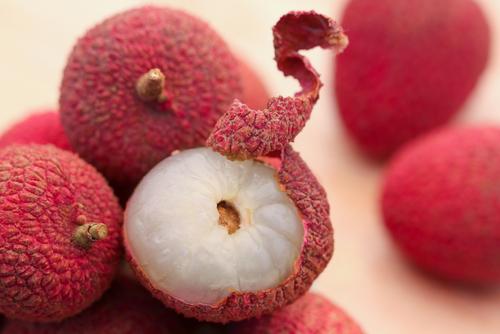If you've been reading ACSH's writings for any time at all, you know that we're not on the "natural is better or safer" bandwagon. We've told you about many naturally-occurring potential health threats, such as arsenic in groundwater and solanine in potatoes. But now, a somewhat bizarre chain of events has uncovered a new, all natural health threat — lychee nuts.
Lychees, which are fruits, not nuts, originally came from China, but now are also grown in Vietnam, Bangladesh and India. They grow in clusters on trees as in the photo below.

The white, translucent lychee fruit is covered by a thin, bumpy skin that turns red when ripe. It contains a reasonable amount of Vitamin C, but isn't particularly rich in other nutrients.
So the current story is about a mysterious, sometimes fatal, ailment affecting young Indian children. In the 1990s, a disturbing observation was made: young Indian children, who had been healthy the previous day were being taken to hospitals where they suffered seizures (acute encephalopathy) — and about 40 percent of them died. Then, each July, when the monsoon rains began, the outbreaks suddenly ceased. Was it some new viral condition carried by sand fleas or other vectors? Or perhaps it was exposure to pesticides used in the lychee orchards common in the area concerned?
Actually, it was neither — no infection or toxic pesticide could be found in the kids' bodies. Careful epidemiological study, published in the Lancet Global Health, revealed that it was the lychees themselves that were responsible. The investigators examined the records of nearly 400 children admitted to 2 hospitals in Muzaffarpur, India. They found that almost 3/4 of them were hypoglycemic, with blood glucose levels of 70 mg/dl or less. Most also had metabolites (breakdown products) of two fruit-based toxins — hypoglycin A and methylenecyclopropylglycine (MCPG). Both are known to cause hypoglycemia and metabolic derangements. Compared to children hospitalized for other conditions, those who had consumed lychees — especially without an evening meal — had a greater than 7-fold risk of developing the encephalopathy. So the "cure" was relatively simple — parents were told to carefully monitor children's lychee consumption and be sure to provide an evening meal, and care providers advised about the importance of providing glucose to children affected by the syndrome.
If this isn't a good example of an all-natural problem — not caused by any man-made chemical, then we can't think of one.




